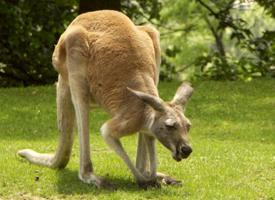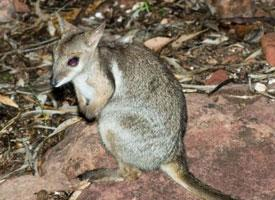
Súlyok és méretek
| Hossz | 1,1-tól 1,4-ig m |
|---|---|
| Súly | 35-tól 85-ig kg |
| Sebesség | 64 km/h |
Állatleírás
The Red Kangaroo (Osphranter rufus), an iconic symbol of the Australian outback, stands as the largest of all kangaroos, as well as being the largest terrestrial mammal native to Australia. This majestic creature is distinguished by its muscular build, powerful hind legs, large feet, and a long, strong tail which it uses for balance while moving. The males, significantly larger than the females, can reach up to 1.8 meters (5.9 feet) in height and weigh around 90 kilograms (200 pounds), while females are generally smaller, lighter, and more agile.One of the most striking features of the Red Kangaroo is its coloration. Males exhibit a rich, reddish-brown coat, from which the species derives its common name, while females tend to have a bluer-grey coat, leading them to be sometimes referred to as "blue flyers." Both sexes, however, possess a white underbelly and, occasionally, white facial markings. The thick, coarse fur serves as an excellent insulator, protecting these animals from extreme temperatures in their desert habitats.
Red Kangaroos are renowned for their incredible ability to leap, a mode of locomotion known as saltation. They can cover distances of up to 8 meters (26 feet) in a single bound and reach speeds of over 56 kilometers per hour (35 miles per hour), thanks to their powerful hind legs. Interestingly, their unique muscular structure and the elastic tendons in their legs allow them to move efficiently, conserving energy even at high speeds. Unlike many mammals, kangaroos cannot walk backwards due to the large size of their muscular tail and the shape of their pelvis.
These animals are predominantly nocturnal or crepuscular, meaning they are most active during the cooler temperatures of the evening or early morning. During the day, they rest in the shade to escape the harsh Australian sun. Red Kangaroos are herbivores, feeding mainly on grasses and small leafy plants. They have developed specialized adaptations to survive in their arid environments, such as the ability to go long periods without water by obtaining moisture from their food and concentrating their urine to conserve water.
Socially, Red Kangaroos live in groups known as mobs, which can vary in size from a few individuals to over a hundred. These groups provide protection against predators and facilitate social interactions. Males within the mob establish a dominance hierarchy, often through boxing matches where they use their front paws to hit their opponents and their powerful hind legs to kick. The dominant male usually has breeding rights to the females in the group.
Reproduction in Red Kangaroos involves a fascinating phenomenon known as embryonic diapause, where the development of the embryo can be paused during adverse environmental conditions. Once conditions improve, or the previous joey leaves the pouch, the embryo resumes development. The gestation period is short, about 33 days, after which a tiny, underdeveloped joey is born and crawls into its mother's pouch to continue development, remaining there for several months.
Red Kangaroos play a significant role in the ecosystem, influencing the structure and composition of their habitats through their grazing. While they are currently listed as Least Concern by the International Union for Conservation of Nature (IUCN), they face threats from habitat loss, competition with livestock for resources, and culling. Conservation efforts focus on ensuring sustainable populations while managing their impact on agricultural lands.
In summary, the Red Kangaroo is a remarkable species, perfectly adapted to the challenges of life in the Australian outback. Its impressive physical attributes, unique reproductive strategies, and complex social structures make it a subject of fascination and an enduring symbol of Australia's natural heritage.
Hasonló állatok
Új állatfotók
Top 10 állat
- Dolphin gull (Leucophaeus scoresbii)
- Diana monkey (Cercopithecus diana)
- Moustached guenon (Cercopithecus cephus)
- Galápagos tortoise (Geochelone nigra complex)
- Japanese macaque (Macaca fuscata)
- Stone loach (Barbatula barbatula)
- Russian tortoise (Testudo horsfieldii)
- Greek tortoise (Testudo graeca)
- Common flying dragon (Draco volans)
- Vendace (Coregonus albula)


